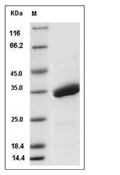Shopping Cart
- Remove All
 Your shopping cart is currently empty
Your shopping cart is currently empty

SPINK4 Protein, Mouse, Recombinant (hFc) is expressed in HEK293 mammalian cells with hFc tag. The predicted molecular weight is 34.5 kDa and the accession number is O35679.

| Pack Size | Price | Availability | Quantity |
|---|---|---|---|
| 100 μg | $451 | In Stock | |
| 200 μg | $771 | 7-10 days | |
| 500 μg | $1,560 | 7-10 days |
| Biological Activity | Activity testing is in progress. It is theoretically active, but we cannot guarantee it. If you require protein activity, we recommend choosing the eukaryotic expression version first. |
| Description | SPINK4 Protein, Mouse, Recombinant (hFc) is expressed in HEK293 mammalian cells with hFc tag. The predicted molecular weight is 34.5 kDa and the accession number is O35679. |
| Species | Mouse |
| Expression System | HEK293 Cells |
| Tag | C-hFc |
| Accession Number | O35679 |
| Synonyms | serine peptidase inhibitor, Kazal type 4,RP23-28I8.2,MPGC60 |
| Construction | A DNA sequence encoding the mouse SPINK4 (NP_035593.2) (Met 1-Cys 86) was fused with the Fc region of human IgG1 at the C-terminus. Predicted N terminal: Gly 27 |
| Protein Purity | > 97 % as determined by SDS-PAGE  |
| Molecular Weight | 34.5 kDa (predicted); 35 kDa (reducing conditions) |
| Endotoxin | < 1.0 EU/μg of the protein as determined by the LAL method. |
| Formulation | Lyophilized from a solution filtered through a 0.22 μm filter, containing PBS, pH 7.4. Typically, a mixture containing 5% to 8% trehalose, mannitol, and 0.01% Tween 80 is incorporated as a protective agent before lyophilization. |
| Reconstitution | A Certificate of Analysis (CoA) containing reconstitution instructions is included with the products. Please refer to the CoA for detailed information. |
| Stability & Storage | It is recommended to store recombinant proteins at -20°C to -80°C for future use. Lyophilized powders can be stably stored for over 12 months, while liquid products can be stored for 6-12 months at -80°C. For reconstituted protein solutions, the solution can be stored at -20°C to -80°C for at least 3 months. Please avoid multiple freeze-thaw cycles and store products in aliquots. |
| Shipping | In general, Lyophilized powders are shipping with blue ice. |
| Research Background | Serine protease inhibitor Kazal-type 4, also known as Peptide PEC-6 homolog and SPINK4, is a secreted protein that contains one Kazal-like domain. SPINK4 is a member of the SPINK protein family. The gene family of serine protease inhibitors of the Kazal type (SPINK) are functional and positional candidate genes for celiac disease (CD). SPINK1 plays an important role in protecting the pancreas against excessive trypsinogen activation. It is a potent natural inhibitor of pancreatic trypsin activity. SPINK1 mutations are associated with the development of acute and chronic pancreatitis and have been detected in all forms of chronic pancreatitis. SPINK2 functions as a trypsin/acrosin inhibitor and is synthesized mainly in the testis and seminal vesicle where its activity is engaged infertility. The SPINK2 protein contains a typical Kazal domain composed by six cysteine residues forming three disulfide bridges. SPINK9 was identified in human skin. Its expression was strong in palmar epidermis, but not detectable or very low in non palmoplantar skin. |

Copyright © 2015-2025 TargetMol Chemicals Inc. All Rights Reserved.